Rainbow Jasper
Rainbow Jasper, or simply Rainbow Stone is a variety of jasper, which is itself a form of chalcedony, a type of microcrystalline quartz. Jasper is known for its vibrant colors, patterns, and unique formations, and Rainbow Jasper is no exception.
 Rainbow Jasper
Rainbow Jasper
Rainbow Jasper gets its name from its striking array of colors, which can include shades of red, yellow, green, brown, and sometimes even blue or purple. These colors often occur in swirling patterns or bands, creating a mesmerizing visual effect reminiscent of the natural spectrum of light after rainfall, thus earning it the name “rainbow.”
This stone is formed through a process of sedimentation, where mineral-rich groundwater permeates porous rock or sediment, depositing layers of minerals over time. These minerals include iron oxides, silica, and other compounds, which contribute to the stone’s diverse color palette.
Rainbow Jasper is appreciated not only for its aesthetic appeal but also for its metaphysical properties. In crystal healing and spiritual practices, it is believed to possess grounding energy, promoting stability, balance, and vitality. Additionally, it is thought to enhance creativity, emotional harmony, and overall well-being.
Due to its beauty and perceived metaphysical properties, Rainbow Jasper is commonly used in jewelry making, as well as in decorative objects and crafts. Its unique colors and patterns make each piece one-of-a-kind, adding a touch of natural beauty to any setting.
Overall, Rainbow Jasper stands out as a captivating gemstone with a rich history, diverse appearance, and potential metaphysical benefits, making it a sought-after choice for both collectors and enthusiasts of natural stones.
Contents
- Geological Formation and Composition
- Physical Characteristics
- Applications and Uses
- Locations of Deposits
Geological Formation and Composition

Rainbow Jasper, like other varieties of jasper, is formed through a combination of geological processes over millions of years. Here’s an overview of its formation and composition:
- Sedimentary Deposition: Rainbow Jasper typically forms within sedimentary rocks, such as shale, limestone, or sandstone. These rocks are originally deposited in layers over long periods, often in ancient seabeds or lakebeds.
- Percolation of Mineral-Rich Water: Over time, groundwater rich in dissolved minerals, such as silica (a key component of quartz), iron oxides, and other trace elements, seeps through the porous sedimentary rock. This water carries the minerals into the rock’s open spaces and fractures.
- Mineral Deposition: As the mineral-rich water infiltrates the sedimentary rock, it deposits layers of minerals in the form of microscopic crystals. These minerals accumulate over time, gradually filling in the gaps and forming the colorful patterns and bands characteristic of Rainbow Jasper.
- Pressure and Heat: As more layers of sediment accumulate above, the pressure from the overlying rock increases. Additionally, the heat from the Earth’s internal processes, such as geothermal activity or tectonic movement, can contribute to the alteration of minerals within the rock.
- Metamorphism: The combination of pressure and heat leads to metamorphism, wherein the sedimentary rock undergoes changes in its mineral composition and structure. While Rainbow Jasper is not typically formed under high-grade metamorphic conditions like some other rocks, it may undergo mild metamorphism, which can enhance its hardness and luster.
- Erosion and Exposure: Over millions of years, geological uplift and erosion expose the Rainbow Jasper-bearing rocks at the Earth’s surface. Weathering processes, such as wind, water, and chemical reactions, gradually wear away the surrounding rock, revealing the colorful jasper formations beneath.
Compositionally, Rainbow Jasper primarily consists of silicon dioxide (SiO2), the chemical compound that forms quartz, along with various impurities that impart its distinctive colors. Iron oxides, such as hematite (Fe2O3) and limonite (FeO(OH)·nH2O), are responsible for the red, yellow, and brown hues, while other trace elements contribute to the green, blue, or purple tones observed in some specimens.
Overall, Rainbow Jasper’s formation involves a complex interplay of geological and chemical processes, resulting in its unique appearance and composition.
Physical Characteristics

Rainbow Jasper exhibits several physical characteristics that contribute to its unique appearance and appeal. Here are some notable features:
- Color: As the name suggests, Rainbow Jasper is renowned for its vibrant array of colors, which can include shades of red, yellow, green, brown, and sometimes even blue or purple. These colors often occur in swirling patterns or bands, giving the stone its distinctive appearance reminiscent of a rainbow.
- Patterns and Banding: Rainbow Jasper commonly displays swirling patterns, streaks, or bands of different colors. These patterns are a result of the mineral deposition process during its formation, as well as subsequent geological forces and alterations.
- Luster: Rainbow Jasper typically has a smooth and somewhat waxy or vitreous (glass-like) luster when polished. This luster enhances the stone’s visual appeal and contributes to its attractiveness in jewelry and decorative items.
- Transparency and Opacity: Rainbow Jasper is generally opaque, meaning that light does not pass through it. However, certain varieties or sections of the stone may exhibit varying degrees of translucency, especially when thinly sliced or polished.
- Hardness: On the Mohs scale of mineral hardness, Rainbow Jasper typically ranges from 6.5 to 7. This places it in the same range as quartz and other forms of chalcedony, making it relatively durable and suitable for use in jewelry and carvings.
- Texture: The texture of Rainbow Jasper can vary depending on factors such as its specific mineral composition and the conditions of its formation. It may exhibit a smooth, polished surface when cut and finished, or it can have a more rough and natural texture, especially in its raw or unpolished state.
- Density and Specific Gravity: Rainbow Jasper has a density ranging from approximately 2.58 to 2.91 grams per cubic centimeter (g/cm³), with variations depending on its mineral content. Its specific gravity falls within a similar range, reflecting its overall density relative to water.
Overall, Rainbow Jasper’s physical characteristics, including its vibrant colors, unique patterns, smooth luster, and moderate hardness, make it a highly desirable gemstone for both aesthetic and practical purposes.
Applications and Uses

Rainbow Jasper finds a variety of applications and uses due to its unique physical characteristics, metaphysical properties, and aesthetic appeal. Here are some common applications:
- Jewelry: One of the most popular uses of Rainbow Jasper is in jewelry making. Its vibrant colors and swirling patterns make it an attractive choice for beads, cabochons, pendants, and other ornamental pieces. Rainbow Jasper jewelry can range from casual to elegant designs, appealing to a wide range of tastes.
- Decorative Objects: Rainbow Jasper’s striking appearance makes it ideal for use in decorative objects and home decor items. It can be fashioned into sculptures, figurines, bookends, paperweights, and other artistic creations. Its natural beauty adds a touch of elegance and uniqueness to any interior space.
- Lapidary Art: Rainbow Jasper is a favorite among lapidaries and artisans who specialize in cutting and shaping gemstones. It can be carved into intricate designs, polished into smooth surfaces, or faceted to enhance its luster and brilliance. Lapidary artists often use Rainbow Jasper to create custom pieces of artwork or to accent other gemstones in jewelry settings.
- Metaphysical and Healing Practices: In metaphysical and healing practices, Rainbow Jasper is believed to possess various spiritual and therapeutic properties. It is thought to promote grounding, balance, and vitality, as well as enhance creativity, emotional stability, and overall well-being. As such, it may be used in meditation, energy healing, or as a talisman or amulet for personal empowerment.
- Collecting and Display: Rainbow Jasper’s unique colors and patterns make it a sought-after item for collectors of gemstones and minerals. Collectors often seek out specimens with exceptional beauty or unusual formations to display in their collections or showcase in mineral shows and exhibitions.
- Gifts and Souvenirs: Due to its natural beauty and symbolic significance, Rainbow Jasper is often chosen as a meaningful gift or souvenir. It can be given to mark special occasions such as birthdays, anniversaries, or graduations, or as a token of friendship, love, or appreciation.
- Crafts and DIY Projects: Rainbow Jasper can be incorporated into various craft projects and DIY creations. It can be used to make keychains, ornaments, mosaic tiles, and other artistic endeavors, allowing crafters to unleash their creativity and express themselves through the beauty of natural gemstones.
Overall, Rainbow Jasper’s versatility and allure make it a versatile gemstone with a wide range of applications and uses, appealing to jewelry enthusiasts, artisans, collectors, and spiritual practitioners alike.
Locations of Deposits

Rainbow Jasper deposits can be found in various locations around the world, although they are not as widespread as some other types of jasper. Some of the notable locations where Rainbow Jasper is known to occur include:
- Madagascar: Madagascar is renowned for its diverse range of gemstones and minerals, including Rainbow Jasper. Deposits of Rainbow Jasper have been found in different regions of the island nation, particularly in areas known for their rich geological diversity.
- South Africa: South Africa is another significant source of Rainbow Jasper. The country’s mineral-rich landscapes have yielded various types of jasper, including specimens with vibrant colors and distinctive banding patterns.
- Australia: Australia boasts a rich geological heritage and is home to numerous deposits of jasper, including Rainbow Jasper. Western Australia, in particular, is known for its abundant mineral resources, and Rainbow Jasper can be found in certain regions of the state.
- United States: Rainbow Jasper can also be found in certain parts of the United States. States such as Oregon, California, and Arizona are known for their jasper deposits, and Rainbow Jasper has been reported from some of these areas.
- Mexico: Mexico is another country where Rainbow Jasper can be found. The country’s diverse geological formations have yielded various types of jasper, including specimens with colorful bands and patterns.
- Other Locations: In addition to the aforementioned regions, Rainbow Jasper may occur sporadically in other parts of the world where suitable geological conditions are present. These locations may include countries with diverse geological landscapes and a history of mineral exploration.
It’s important to note that the availability of Rainbow Jasper can vary over time, and new deposits may be discovered as geological surveys and exploration efforts continue. Additionally, the quality and quantity of Rainbow Jasper specimens can vary from one location to another, influencing their desirability and market value.
 100mm Grand Dali Rainbow Jasper aka Pork Stone Crystal Sphere
100mm Grand Dali Rainbow Jasper aka Pork Stone Crystal Sphere
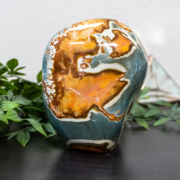
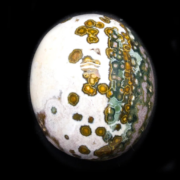
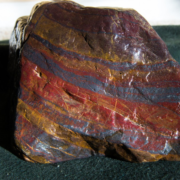
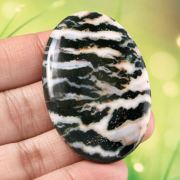
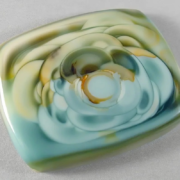
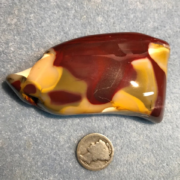


Leave a Reply
Want to join the discussion?Feel free to contribute!